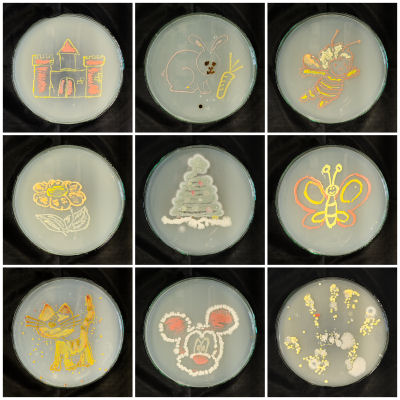|
Strona archiwalna!
Ta strona zawiera treści archiwalne, które nie były zmieniane po 23 września 2019 r. Jeśli chcesz wiedzieć więcej zapoznaj się z deklaracją dostępności
|
||||||
archiwum
 2006 2006
 2008 2008
 2010 2010
 2012 2012
 2014 2014 |
||||||

| ||||||
 |
 |
|||||

|
||||||
| strona główna założenia regulamin kalendarium wskazówki pobierz jury rejestracja zgłoszone projekty galeria gallery | archiwum kontakt | |||||
Description popularizing the research project An art museum is the place where painting and microbiology most often meet. We can even conclude that it is where the two domains literally permeate each other. Yet, it is not a fashionable marriage of science and art, connoisseurs would covet. On the contrary. Art conservators do everything they can to prevent too close contacts between the two as the result would be irreversible damage to the priceless masterpieces. Fungal spores floating in the air would settle on the surface of the paintings and cover burnt sienna, vermilion and ultramarine of landscapes and portraits with a layer of mould. It would be then hard to discover what colour is hiding behind the cryptic name of the paint. It would be even harder to save the work of old or contemporary masters from destruction brought by microscopic fungi or bacteria. Yet, if we replaced ultramarine with Vogesella indigofera, vermilion with Serratia marcescens and other colours with other bacteria of names as mysterious as the names of the colours themselves, we could have images painted with colonies of microorganisms. After a few dozens of hours from a gentle stroke on an agar plate made with an inoculation loop dipped in a suspension of cells of given bacteria, a patient microbiologist with a soul of an artist would obtain a multicolour image in a Petri dish. Abstract Zespół badawczy: Paulina Biniecka, Nataniel Białas, Kinga Bondarczuk, Sławomir Borymski, Regina Galimska-Stypa, Celina Jamrozy, Katarzyna Kasperkiewicz, Marzena Ksiądz, Anna Markowicz, Magdalena Noszczyńska, Magdalena Pacwa-Płociniczak, Małgorzata Pawlik, Tomasz Płociniczak, Monika Rajtor, Teresa Starczyk, Sławomir Sułowicz, Sonia Urbaniec, Zofia Piotrowska-Seget. Studies performed at the Department of Microbiology UŚ are focused on determin-ing the influence of anthropogenic contaminations on the biodiversity of microorganisms living in terrestrial and aquatic environments. Research concerns evaluation of changes in the structures of microbial communities inhabit-ing areas polluted with heavy metals, pesticides and aromatic hydrocarbons. Attempts are made to apply bacteria and fungi, originally isolated from these contaminated environments, in the process of bioremediation. Endophytic bacte-ria which are able to promote the growth of heavy metal-accumulating plants and mycorrhizal fungi involved in the degradation of organic compounds have been successfully isolated. Furthermore, the problem of the overuse of antibiotics in medicine and agriculture which expands the resistance reservoir among environmental strains is also investigated. It has been determined that pathogenic bacteria may contribute to the development of auto immune diseases. Our team study one of such diseases (juvenile idiopathic arthritis) using a murine model and we analyse the architecture of bacterial extracellular structures which trigger the immune response as well. Microorganisms, despite their microscopic size, have a great potential which the Silesian microbiologists want to utilize in the service of the mankind and the environment. Impossible? On the contrary! The research was supported by: 1. Response of plant and endophytic microbial communities to soil inoculation with metalresistant endophytes with plant growth promot-ing activities (NCN - OPUS 2013/11/B/NZ9/00152) 2. Investigation of the role of the mannan-binding lectin in juvenile idiopathic arthritis associated with Yersinia infections (NCN - OPUS 2011/01/B/NZ6/00264) 3. The characterization of microbial communities residing in sewage sludge and sludge amended soils with a special focus on antibiotic and metal resistance (NCN - SONATA 2013/11/D/NZ9/02519) 4. Characterization of community structure of environmental bacteria residing in a water body which receives treated wastewater with the emphasis on plasmid-encoded antibiotic resistance (NCN-PRELUDIUM 2014/13/N/NZ9/03915) 5. Characteristics of endophytic bacteria isolated from plants growing in the hydrocarboncontaminated soil (NCN - PRELUDIUM 2013/09/N/NZ9/01606) 6. Characteristics of rhi-zoshpere microbial communities of metallophytes growing on metalliferous soil (NCN - PRELUDIUM 2012/05/N/NZ9/02405) 7. Effect of long-term fungicide pressure on structural and functional biodiversity of soil microbial communities and their response to new applied fungicide tetraconazole (NCN - PRELUDIUM 2011/01/N/NZ9/00245) 8. Monitoring of the structure of microbial communities in petroleum contaminated soil inoculated with hydrocarbon-degrading and biosurfactant-producing bacteria (NCN - PRELUDIUM 2011/03/N/NZ9/02089)
|


|
|||||












